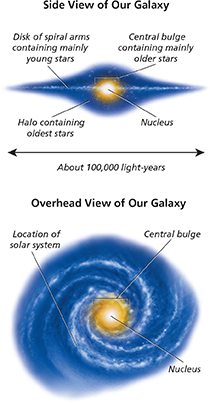The Milky Way Galaxy
On a clear, dark night far from city lights, you can see a faint white band stretching across the night sky. This is the Milky Way. The Milky Way galaxy has an estimated 200 to 400 billion stars and a diameter of more than 100,000 light years. Every individual star that you can see with the unaided eye is in our galaxy. As Figure 23 shows, the solar system lies in the Milky Way's disk within a spiral arm, about two thirds of the way from the center. From Earth we are looking at the rest of the Milky Way edgewise, so it appears as a band in our night sky, rather than a spiral.
The Milky Way's flattened disk shape is caused by its rotation. The sun takes about 220 million years to complete one orbit around the galaxy's center. At the center of the galaxy is a bulge of stars surrounded by an immense halo of globular clusters. Recent evidence suggests that there is a massive black hole at our galaxy's center. Extending outward and winding through the galaxy's disk are spiral arms of gas, dust, and young stars. Stars are forming in these spiral arms.
Quasars
In the 1950s astronomers were mystified by the discovery of distant objects they called quasars. By studying their spectra, astronomers have determined that quasars (KWAY zahrz) are the enormously bright centers of distant, young galaxies. Quasars produce more light than hundreds of galaxies the size of the Milky Way. What makes a quasar so bright? The most likely explanation involves matter spiraling into a super-massive black hole with the mass of a billion suns. The gravitational potential energy of this matter is transformed into electromagnetic radiation as it falls into the black hole.
Figure 23 In a side view, the Milky Way appears as a flat disk with a central bulge. An overhead view of the Milky Way shows its spiral shape.
 d
dSection 26.4 Assessment
Reviewing Concepts
 How are the majority of stars grouped?
How are the majority of stars grouped? How are open clusters and associations different?
How are open clusters and associations different? What are the four major types of galaxies?
What are the four major types of galaxies?Describe the Milky Way and its characteristics.
What is a quasar?
Critical Thinking
Inferring Why were telescopes needed to discover star systems?
Classifying Which type of star cluster has the greatest percentage of old stars?
Inferring How would you use an H-R diagram to distinguish an elliptical galaxy from a spiral or irregular galaxy?
Connecting Concepts
Gravity Use what you learned about the gravitational attraction that acts between two masses in Section 12.4 to explain why the star Sirius A wobbles.




